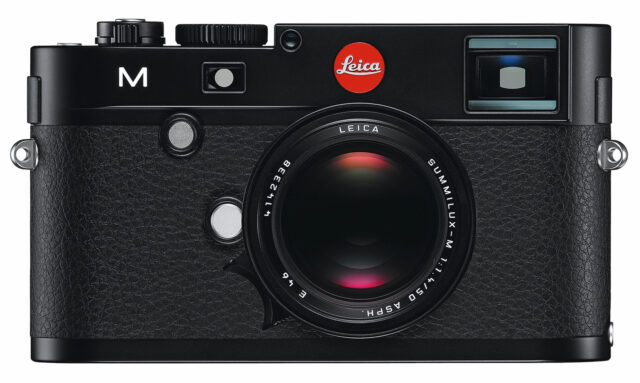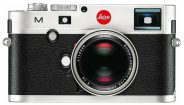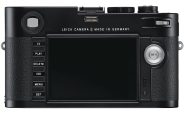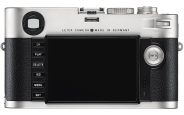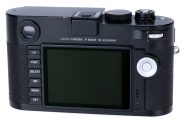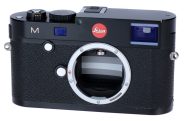Announced
Production status
Order No.
System
Downloads
Leica M system cameras
- Leica M (Typ 240)
- Leica M (Typ 262)
- Leica M Monochrom
- Leica M Monochrom (Typ 246)
- Leica M-A (Typ 127)
- Leica M-D (Typ 262)
- Leica M-E (Typ 220)
- Leica M-E (Typ 240)
- Leica M-P (Typ 240)
- Leica M1
- Leica M10
- Leica M10 Monochrom
- Leica M10-D
- Leica M10-P
- Leica M10-R
- Leica M11
- Leica M11 Monochrom
- Leica M11-P
- Leica M2
- Leica M3
- Leica M4
- Leica M4-2
- Leica M4-P
- Leica M5
- Leica M6
- Leica M6 (Typ 2248)
- Leica M6 Panda
- Leica M6 Titanium
- Leica M6 TTL
- Leica M6J
- Leica M7
- Leica M8
- Leica M8.2
- Leica M9
- Leica M9-P
- Leica MD
- Leica MD-2
- Leica MDa
- Leica MP
- Leica MP Original
Leica M (Typ 240)
35mm MF digital rangefinder camera • Discontinued
Specification
| Format: | |
| 35mm full frame | |
Imaging sensor: | 35.8 × 23.9mm CMOS sensor |
Resolution: | 5976 × 3992 - 24 MP |
Sensor-shift image stabilization: | - |
| Leica M [27.8mm] | |
| Shutter: | |
Type: | Focal-plane |
Model: | Electronically controlled |
Speeds: | 60 - 1/4000 + B |
| Exposure: | |
Exposure metering: | Through-the-lens (TTL), stop-down |
Exposure modes: | Aperture-priority Auto |
| Manual | |
| Rangefinder and Viewfinder: | |
Rangefinder: | Built-in, combined with viewfinder |
Viewfinder: | Built-in, combined with rangefinder |
Finder magnification: | 0.68x |
Actual rangefinder base: | 69.25mm |
Effective rangefinder base: | 47.09mm |
Bright-line frames: | 35mm & 135mm, 28mm & 90mm, 50mm & 75mm |
Parallax compensation: | Yes |
| Physical characteristics: | |
Weight: | 680g |
Dimensions: | 138.6x80x42mm |
| Accessories: | |
Body cap: | 14195 |
| 14397 |
Manufacturer description #1
Solms, Germany (September 17, 2012) - Leica Camera presents a groundbreaking milestone in the nearly 60 year history of the Leica rangefinder system: The Leica M. Setting entirely new standards, the Leica M unites the ultimate in rangefinder precision with cutting edge digital technology. As the first camera to implement a newly designed CMOS image sensor and to feature additional focusing methods and functions such as Live View and Full HD video capability, it is the most versatile Leica rangefinder model ever. Remaining true to the legendary values of the M-System, the Leica M not only provides the advantages of rangefinder photography, but also for the first time, offers compatibility with Leica R legacy lenses. As with every innovation and development since the flagship line’s inception, the Leica M was created to capture fleeting moments of time and transform them into living history.
The Leica M also marks the beginning of a new era in the Leica product naming policy. In future, Leica M and S model names will omit the number suffix to emphasize the enduring and long-term significance of the respective systems.
In every respect, the new Leica M is the most innovative and versatile model the modern M-System has ever created. Looking to the future, the Leica M is the first in a long line of Leica rangefinder cameras to feature a completely new development in sensor technology; the Leica Max CMOS image sensor. This 24 MP, full 35 mm format sensor was designed and constructed in collaboration with CMOSIS especially for the camera and its use with M- and R-Lenses. This new development successfully transfers the characteristic advantages of CCD sensors, such as natural and brilliant color rendition and impressive reproduction of details, to a CMOS sensor.
In combination with the high-performance Leica Maestro processor that is also employed in Leica S cameras, this new full format sensor guarantees maximum imaging quality and speed. Now, all elements in the image creation chain, from the lens to the image file, are under complete control of the Leica engineers. This guarantees the ultimate in imaging performance and quality. An additional highlight is the low power consumption of the components that, in conjunction with the particularly high capacity of the battery, ensures outstanding performance over a long period of use.
In 1954, the launch of the M-System opened new horizons in reportage and artistic photography. Now at the dawn of a new era in the system’s technology, the Leica M offers a multitude of new features. The first of these are Live View and Live View Focus. Image composition can now take place in real time with the view of the subject through the lens. The sharpness, exposure and color content of images can now be precisely assessed on the camera’s large, 3-inch, high-resolution monitor screen with 920,000 pixels. The glass covering plate of the monitor screen is manufactured from particularly tough and scratch-resistant Corning®Gorilla®Glass. The new Live View function allows photographers to have access to entirely new opportunities that, in combination with the outstanding performance of Leica M- and R-Lenses, go far beyond the classical capabilities of rangefinder photography. This applies particularly to macro and telephoto photography, but also allows even more discreet shooting. In combination with M- and R-Lenses, the camera’s new 1080p Full HD video capability also opens up further opportunities to record memories as they happen.
Ever in pursuit of capturing Henri Cartier-Bresson’s “Decisive Moment,” the Leica M offers two additional focusing methods that can be activated quickly and easily with the new focus button. M-Photographers now have even more options for capturing outstandingly sharp images. The new ‘Live View Zoom’ option enables up to 10 x magnification for precise assessment of the sharpness of subject details or the close focusing limit. The second aid to focusing is ‘Live View Focus Peaking’. Here, contours in the subject are automatically displayed as red lines to allow simple and convenient focus assessment. Focusing precision can be assessed on the basis of the intensity of the lines displayed.
The Leica M’s features are optimally combined with the typical values of the Leica rangefinder system and guarantee the accustomed dependability of the Leica M in all photographic situations, from available light photography to discreet and aesthetic fine-art image composition. In line with the principles of the M-Philosophy, all functions and features are designed and constructed for absolute robustness and a long working life. The top deck and the base plate of the Leica M are machined from solid brass blanks and the full-metal chassis is a completely self-contained diecast element manufactured from high-strength magnesium alloy. Special rubber seals protect the camera body against dust, spray and moisture.
The new rangefinder camera is also a typical M due to its intuitive handling concept with direct manual setting options and fast access to functions. The enhanced layout and particular user-friendliness of the menu interface guarantees a clear and uncomplicated overview of all camera settings at all times. Dedicated button controls have been provided for the Live View and new focusing functions. Live View Zoom and Live View Focus Peaking can be selected with the new focus button on the front of the camera. User profiles can be programmed with any camera and shooting settings, stored under an arbitrary name. They can be accessed quickly whenever required for particular situations and can now also be saved to an SD memory card. For increased comfort in use and harkening to the film advance lever of Leica film cameras, the Leica M now provides an ergonomically formed thumb rest with an integrated setting dial at the top right on the back of the top deck. This ensures that the camera can be held securely in even the most demanding situations.
A wide range of optional accessories is also available for the new Leica M. A particular highlight of the range is a new Leica R-Adapter M that allows almost all R-Lenses ever built to be mounted on the camera. The use of Leica R-System lenses now opens up vast new possibilities for zoom, telephoto and macro photography.
Further accessories are the Leica EVF2, Visoflex electronic viewfinder and a multifunctional handgrip-M with an integrated GPS module that, in combination with optional finger loops in various sizes (S, M and L), helps to ensure safe and steady handling of the camera and lens system. The range also includes a Leica Microphone Adapter set for perfect sound with video recordings.
The Leica M will be available from Leica dealers, including the Leica Store Washington DC, in early 2013 in a choice of black paint or silver chrome finish.
Manufacturer description #2
The Leica M rigorously adheres to the philosophy of the M-System. It is a milestone that points the way to the future. The Leica M reaps the benefits of more than 60 years of experience with the M rangefinder system. At the same time, it exploits forward-looking digital technologies: it features a high-resolution, full-format CMOS sensor that, in combination with its high-performance processor and the legendary M-lenses, delivers outstanding imaging results – typical of M-Cameras. But with Live View, video, and additional focusing methods, it is also the M for photographers that do not want to miss out on any of the benefits of modern digital technology. The M successfully expands the scope of the M-System while remaining true to its fundamental heritage and principles.
The Leica M embodies six decades of experience with the modern M rangefinder system plus the innovative potential of the digital age. It is a superb example of what is currently the world’s most compact, full-frame camera system. And it is one of the most compact full-format system cameras currently available. Moreover, its 24 × 36 mm CMOS sensor delivers the full 35 mm format without compromises. System compatibility has always been a hallmark of the Leica M-System and the M is no exception: it benefits from access to the entire portfolio of M-Lenses, widely acclaimed as the world’s best lens system. Introduced in 1954, it has been continually advanced and improved ever since. And today, almost all M-Lenses ever made are compatible for use with the digital M. But that’s not all: with the Leica R-Adapter, almost all Leica R-Lenses can also be used with the Leica M. And this expands its options into the world of Leica R photography. The successful story of the Leica M-System continues to unfold.
The Leica M features a high-resolution, 24-megapixel CMOS sensor in the full 35 mm format. In combination with the Leica Maestro image processor, already employed in the Leica S-System, the Leica Max 24-MP sensor is responsible for the outstanding imaging quality of the Leica M. For the first time in the history of the digital M-System, all components in the image creation flow, from lens to image file, were developed in-house by Leica. Here, our team of engineers has successfully perfected the entire image creation chain for use with M- and R-Lenses without any compromises, in order to exploit the full potential of these lenses. The consequence of this integration can be seen in images with superior sharpness and the finest reproduction of details. The M delivers extremely low-noise and richly detailed images, even at higher sensitivities of up to ISO 6400. In combination with fast Leica lenses, this low noise capture capability makes the camera an ideal tool for available-light photography. Thanks to the integrated imaging electronics of the Leica Maestro image processor, the Leica M is also distinguished by fast response times and an almost instantaneous wake-up time – ensuring that photographers are always ready to shoot.
In conjunction with the sensor, the Leica Maestro processor enables the Leica M to set new standards in terms of image-processing speed. It processes the image data arriving from the sensor and transforms them into visible images at lightning speed. But this elaborately designed and developed sensor doesn’t only make the M an incredibly fast camera, it also enables even greater capabilities. The Maestro processor contains several independently active, functional segments that allow it, for example, to process an incoming image while it is still writing the data of the previous image to the memory card. It can also perform complex processing steps at extremely high speed. At the same time, its extremely low power consumption has a positive effect on battery life. Due to its powerful image processor working in tandem with its high-resolution sensor, the Leica M can generate a high-quality JPEG file in the camera – simultaneously with a DNG raw data file destined for final optimization on a computer, if required.
The Leica M is the first M ever to feature Live View and Live View Focusing. This means that now, for the first time, M-System images can be composed using the actual image produced by the lens – with complete control of depth of field, exposure, precise framing, and focusing. Its large, high-resolution 3" monitor with 920,000 pixels allows precise assessment of each potential or captured image with regard to sharpness, exposure accuracy, and color. This opens up entirely new opportunities for M-Photographers that previously were far beyond the limitations of viewfinder- controlled photography. This applies particularly to macro and telephoto exposures, but also allows even more discreet photography by using the monitor instead of the sometimes too obvious technique of glancing through the viewfinder. The Live View function can be used to its full extent with both M- and R-Lenses. Indirectly, the Live View option offers an additional attractive benefit for R-Lens owners. It enables the use of an optional Visoflex EVF 2 electronic viewfinder with Live View. This means that a Leica M with an R-Adapter, R-Lenses, and a viewfinder can be used exactly like an SLR, that is, without using the LCD monitor.
Leica lenses are famous for their superior resolution, high speeds, and attractive bokeh. The unique quality of Leica lenses can also be exploited with the Full HD 1080 pixel video recording function of the Leica M. Recording can be initiated directly with a separate dedicated release button. Complete control over exposure and capture settings enables photographers to complement their still images with professional caliber video recordings. And with the same well known look and quality that characterizes Leica M still images. The Leica M offers the option of recording images as Motion JPEGs, i. e. as true, individual full frames, which brings enormous advantages for video editing. In the same manner as with still images, the Leica R-Adapter also allows video recording with R- Lenses that can be mounted on the Leica M without any loss of functionality. Perfect sound is ensured by using an optional Leica microphone adapter set, comprising an adapter and a stereo microphone. Another practical touch: other microphones can be attached with the adapter.
The classic M rangefinder system guarantees fast, precise, and crystal-clear focusing along with superior accuracy irrespective of the lens in use, particularly with wide-angle lenses. The Leica M offers two additional focusing methods that can be activated quickly and easily with the focus button.
The Live View Zoom enables up to 10-fold magnification of the Live View display for complete control over precise focusing on fine details or assessing sharpness at the close focusing limit. Another highlight is Live View Focus Peaking: here, automatic highlighting of contours in red provides convenient focus control. This contour display enables more precise assessment of focusing accuracy. Depending on the situation or the photographer’s preferences, M-Users can now choose from several effective options for achieving exquisitely sharp images.
Robust and enduring, it is not rare for a Leica to become its owner’s lifelong companion. This applies especially in the case of the M. Thanks to the many years of experience gathered by our engineers in the construction of camera bodies, not only the M-System, but also the R- and S- Systems are built without compromise for maximum stability and perfect weather sealing. Its top deck and base plate are machined from solid brass blanks and its full-metal body is manufactured from a single piece of high-strength magnesium alloy. The glass cover plate of its high-resolution LCD monitor screen is manufactured from especially tough and scratch-resistant Corning® Gorilla® Glass. Specially designed rubber seals protect its body against splashes, moisture, and dust. And this means that taking a Leica M wherever you go is a distinct pleasure in any weather.
The lithium-ion battery (1,800 mAh) in the Leica M means that even extremely long photo sessions can be captured without having to look for a power socket. Thanks to this high-performance rechargeable battery, energy-saving exposure metering electronics, and the energy-saving imaging electronics of the Leica Maestro image processor and the sensor, a single charge guarantees an enormous number of exposures. This also makes photography far from the beaten track an extended and enjoyable experience.
A user concept with intuitive handling, direct manual control options, and rapid access to all important photographic functions was an essential part of the digital M-System philosophy right from the start. The attractive features of the Leica M have changed nothing in this respect. In addition to manual focusing and direct setting options for the aperture and shutter speeds, the combination of an ergonomically positioned control wheel on the top deck and intuitive menu navigation make up the heart of its operating concept. The supremely user-friendly menu interface displayed on the large rear monitor guarantees a clear overview of all camera settings at all times. And this assures that M-Camera owners can always concentrate on what’s essential – their pictures.
True to the principles of the M-philosophy, the video and Live View functions and the focus functions each have their own buttons. The focus button on the front of the camera allows not only the selection of Live View Zoom and Live View Focus Peaking, but also fast and easy exposure corrections with the conveniently placed control wheel. ISO sensitivity settings can also be controlled with a dedicated button. The Set button provides direct access to white balance, image file compression, resolution, exposure compensation, bracketing, and user profiles. In user profiles, any camera and exposure settings can be saved under a user-selected name and rapidly accessed whenever required. These profiles can even be saved to an SD card. For increased handling comfort, the Leica M also features an ergonomically formed thumb rest at the top-right end of the top deck. This ensures an ideal grip and stability even under the most demanding shooting situations. In addition, the generously dimensioned high-resolution 3" monitor guarantees maximum ease of image assessment.
The Leica R-Adapter allows almost all Leica R-Lenses to be mounted on the Leica M. The extensive range of R-Lenses, from various wide-angles, telephoto, and macro lenses to a selection of zooms, offers almost limitless opportunities for expanding the capabilities of the Leica M-System. Additional support for the use of R-Lenses is provided by the optional Visoflex EVF 2 electronic accessory viewfinder.
In conjunction with the high-performance Leica Maestro processor, the Leica Max 24-MP high- resolution, full-format (35 mm) sensor ensures the maximum imaging quality and speed of the Leica M. The sensor is an innovative, high-tech product developed by Leica in collaboration with CMOSIS especially for the Leica M, and for use with M- and R-Lenses. This development has successfully transferred the characteristic advantages of CCD sensors to a CMOS sensor, and preserves the natural, brilliant color rendition and impressive detail resolution characteristic of CCD sensors. But that is by no means the only impressive feature of this energy-saving sensor. Its particularly flat pixel architecture enables the positioning of the light-sensitive area of each pixel much further forward. This means that each individual pixel can capture light from all directions and at larger angles of incidence than a conventional sensor. An additional microlens array gathers even more light. Thanks to smart, innovative sensor design, more space is also available for each individual pixel. The end result of this intensive sensor development process is an impressive dynamic range and excellent contrast rendition that ensures noise-free and brilliant imaging results.
Fast and simple focusing is also offered by the Live View Focus Peaking function. It automatically highlights all contours in the focused image in red. This linear display indicates when a subject is sharply focused and whether a focusing adjustment should be applied. In addition to Live View Zoom and classical focusing method using the rangefinder, this means that the camera offers users a further alternative option for enhanced focusing precision.
Special editions (3)
- Leica M (Typ 240) "20th Anniversary Map Camera" (20 units) - January 2015
- Leica M (Typ 240) "Daimaru department store 300th Anniversary" (50 units) - March 2017
- Leica M (Typ 240) "India Edition" (70 units) - April 2017
